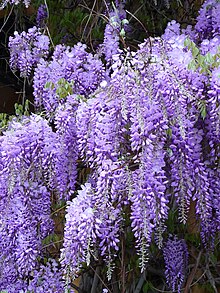
Back وستارية Arabic بليعه ARZ Filbahar Azerbaijani Глициния Bulgarian ভাগীরথী ঝুরি Bengali/Bangla Glicinija BS Anglesina Catalan Wisteria CEB Vistárie Czech Blåregn Danish
This article needs additional citations for verification. (June 2024) |
| Wisteria | |
|---|---|

| |
| Flowering Wisteria sinensis | |
| Scientific classification | |
| Kingdom: | Plantae |
| Clade: | Tracheophytes |
| Clade: | Angiosperms |
| Clade: | Eudicots |
| Clade: | Rosids |
| Order: | Fabales |
| Family: | Fabaceae |
| Subfamily: | Faboideae |
| Tribe: | Wisterieae |
| Genus: | Wisteria Nutt. (1818), nom. cons. |
| Synonyms[1] | |
| |
Wisteria is a genus of flowering plants in the legume family, Fabaceae (Leguminosae). The genus includes four species of woody twining vines that are native to China, Japan, Korea, Vietnam, southern Canada, the Eastern United States, and north of Iran. They were later introduced to France, Germany and various other countries in Europe. Some species are popular ornamental plants. The genus name is also used as the English name, and may then be spelt 'wistaria'.[2][3] In some countries in Western and Central Europe, Wisteria is also known by a variant spelling of the genus in which species were formerly placed, Glycine. Examples include the French glycines, the German Glyzinie, and the Polish glicynia.[citation needed]
The aquatic flowering plant commonly called wisteria or 'water wisteria' is Hygrophila difformis, in the family Acanthaceae.